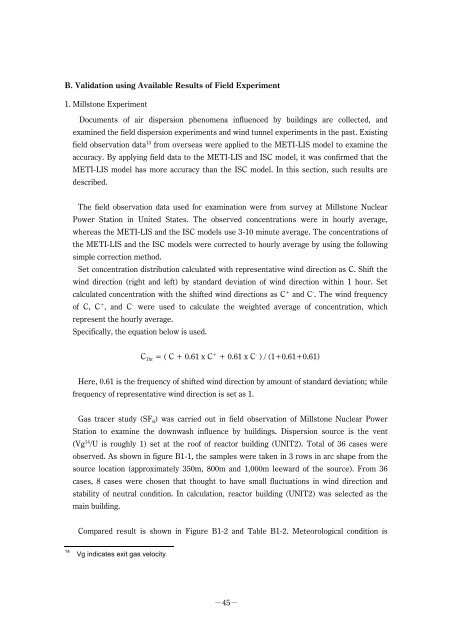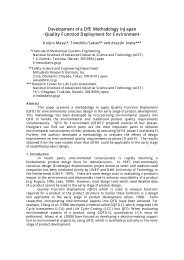METI-LIS Technical Manual
METI-LIS Technical Manual
METI-LIS Technical Manual
You also want an ePaper? Increase the reach of your titles
YUMPU automatically turns print PDFs into web optimized ePapers that Google loves.
B. Validation using Available Results of Field Experiment<br />
1. Millstone Experiment<br />
Documents of air dispersion phenomena influenced by buildings are collected, and<br />
examined the field dispersion experiments and wind tunnel experiments in the past. Existing<br />
field observation data 13 from overseas were applied to the <strong>METI</strong>-<strong>LIS</strong> model to examine the<br />
accuracy. By applying field data to the <strong>METI</strong>-<strong>LIS</strong> and ISC model, it was confirmed that the<br />
<strong>METI</strong>-<strong>LIS</strong> model has more accuracy than the ISC model. In this section, such results are<br />
described.<br />
The field observation data used for examination were from survey at Millstone Nuclear<br />
Power Station in United States. The observed concentrations were in hourly average,<br />
whereas the <strong>METI</strong>-<strong>LIS</strong> and the ISC models use 3-10 minute average. The concentrations of<br />
the <strong>METI</strong>-<strong>LIS</strong> and the ISC models were corrected to hourly average by using the following<br />
simple correction method.<br />
Set concentration distribution calculated with representative wind direction as C. Shift the<br />
wind direction (right and left) by standard deviation of wind direction within 1 hour. Set<br />
calculated concentration with the shifted wind directions as C + and C - . The wind frequency<br />
of C, C + , and C - were used to calculate the weighted average of concentration, which<br />
represent the hourly average.<br />
Specifically, the equation below is used.<br />
C 1hr = ( C + 0.61 x C + + 0.61 x C - ) / (1+0.61+0.61)<br />
Here, 0.61 is the frequency of shifted wind direction by amount of standard deviation; while<br />
frequency of representative wind direction is set as 1.<br />
Gas tracer study (SF 6 ) was carried out in field observation of Millstone Nuclear Power<br />
Station to examine the downwash influence by buildings. Dispersion source is the vent<br />
(Vg 14 /U is roughly 1) set at the roof of reactor building (UNIT2). Total of 36 cases were<br />
observed. As shown in figure B1-1, the samples were taken in 3 rows in arc shape from the<br />
source location (approximately 350m, 800m and 1,000m leeward of the source). From 36<br />
cases, 8 cases were chosen that thought to have small fluctuations in wind direction and<br />
stability of neutral condition. In calculation, reactor building (UNIT2) was selected as the<br />
main building.<br />
Compared result is shown in Figure B1-2 and Table B1-2. Meteorological condition is<br />
14<br />
Vg indicates exit gas velocity.<br />
-45-




